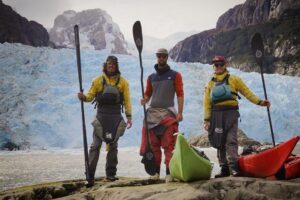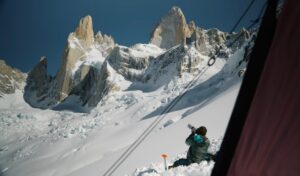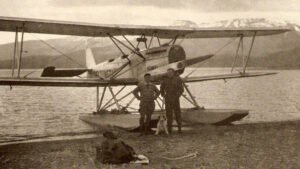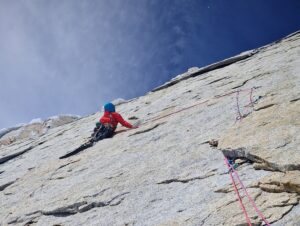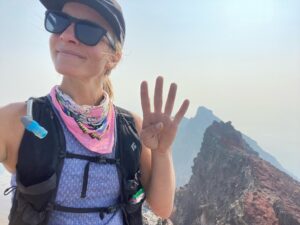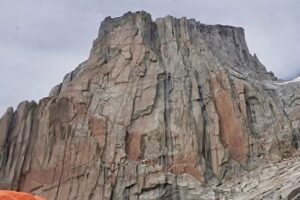Patagonia’s mountains and impressive granite towers are ideal for hardcore alpinism.
“While in the highest mountains on the planet, mountaineering has lost its raison d’etre, with the abuse of fixed ropes, oxygen, and the assistance of Sherpas, in massifs such as those of Patagonia, climbs continue in total autonomy,” Basque climber Eneko Pou wrote a few days ago. “You don’t have anyone around to open the difficult pitch for you, open the track for you in deep snow, carry your backpack, prepare your food, or set up the tent when you’re tired.”
With that freedom and independence comes danger. Let’s examine why Patagonia is dangerous and why it’s so hard to rescue climbers.

Aguja Poincenot (Poincenot Spire). Photo: Sebastian Alvaro
Garibotti’s reports
Every year, Argentinian-American climber Rolando Garibotti writes an excellent climbing report on Patagonia for the American Alpine Journal. His reports also detail accidents.
Garibotti attributes the major causes of fatal accidents to falls, lack of planning and strategy, and extreme weather.

The Goretta Pillar on Fitz Roy. Photo: Matteo Della Bordella
But plenty of other factors come into play too: avalanches, falling debris, the over-eagerness of climbers after bad weather, exposure, and poor self-rescue skills. Some climbers fail to take an InReach or VHF radio with them. All these factors can inhibit rescue efforts.
Skills and risk calculation
Every year, more climbers and tourists head to Patagonia. But not everyone is aware of the danger.
“In many ways, these mountains are much more serious than anything in the Alps or the contiguous U.S. and shouldn’t be taken lightly,” climber Colin Haley wrote, following two fatal climbing accidents late last year. “Weather conditions are very changeable and sometimes brutal,” climber Sebastian Alvaro told ExplorersWeb.
With unpredictable weather, risk calculation is important, and this is often related to the maturity of the climbers. “The older and more experienced you get, the more conservative and cautious you become about the risk you are taking in relation to your skills and abilities,” Mexican climber Ixchel Foord told us.
Risk calculation is doubly important in the event of an emergency because climbers must rely on a volunteer rescue team.

Markus Pucher summits Aguja Guillaumet in 2017 during the first solo winter climb of the spire. Photo: Markus Pucher
All volunteers
There is no professional rescue team for Patagonia. Rather, a volunteer group called the Comision de Auxilio of El Chalten typically carries out the rescues. This group of highly experienced mountain guides helps those in need, sometimes risking their own lives in the process.
“They are very good and strong, and they ‘leave their skin’ to help,” Pou told ExplorersWeb. “We have been climbing in Patagonia for the last 17 years and I can tell you that these volunteers know perfectly what to do in case of an emergency. If they say that they cannot carry out a rescue, it is because it really cannot be done.”

Tommy Aguilo and Korra Pesce’s route on Cerro Torre in 2022. Photo: Tommy Aguilo
No helicopters
Perhaps the biggest hurdle to a swift and easy rescue is the lack of helicopters. Carolina Codo, responsible for the Comision de Auxilio of Chalten, has been asking for a helicopter for a long time.
The nearest helicopter is a military police helicopter in Calafate but it is not prepared for longline rescues.
“Helicopters are not usually available for rescue in this area: in 83% of the 120 rescues carried out over the last 20 years, there was no helicopter involved,” Garibotti wrote in his 2019 report.
In 2014, one of the few rescue attempts to use a helicopter ended in tragedy when pilot Pablo Argiz Vale died in the northern part of the Fitz Roy glacier. The helicopter belonged to another person in Calafate. Vale had flown into the Chalten area to help a climber who fell into a crevasse while traveling unroped on a glacier, but Vale crashed before reaching him.

The summit of Cerro Torre. Photo: Matteo Della Bordella
You might have to rely on other climbers
The volunteer rescue team often asks climbers in the area to help. But these climbers may not be doing the same route and access to these huge towers can be very tricky. Sometimes the approach is as difficult as the climb itself.
“Once we having dinner in El Chalten after a very difficult climb when we were told of a rescue operation taking place,” Pou told ExplorersWeb. The exhausted climbers must then gather their strength to go back up a route that they may not know. It is very dangerous.
The sudden weather changes also hinder rescues. If bad weather arrives, there is no way to reach an accident. If there is an accident on the walls themselves, rescue is likely impossible.
“Wall rescues are not currently possible here, other than self-rescue. Not a single wall rescue has ever been successful in the area,” Garibotti writes.

Volunteer climbers and local rescuers during the rescue attempt on Cerro Torre in 2022. Photo: Thomas Huber
Recent accidents
Even well-prepared climbers with outstanding experience can get into trouble. January 28 will be the first anniversary of the fatal accident of renowned Italian climber Corrado Pesce. Rockfall hit Pesce and his Argentine partner Tommy Aguilo on Cerro Torre. Despite the mobilization of rescuers and other volunteer climbers, they could not rescue him.
On January 19, 2023, an avalanche dragged two experienced Basque climbers, 31-year-old Amaia Agirre and 29-year-old Iker Bilbao, into a crevasse while descending from the summit of Fitz Roy.
The third member of the party avoided the avalanche but could not find Agirre and Bilbao.

Hurricane winds hit Cerro Torre and Torre Egger. Photo: The Pou Brothers
The third team member alerted La Comision de Auxilio of El Chalten two hours and 45 minutes later.
Conditions were very dangerous and new avalanches were a real threat. Because of the lack of a rescue helicopter, climbers and rescuers would need at least eight hours to reach the crevasse. This was too long for the two climbers, who were buried in a crevasse of unknown depth.

Hayden Webster climbs on the Brecha de los Italianos section on Fitz Roy. Photo: Hayden Webster
Avalanche rescue
Mountaineering instructor Zoltan Szlanko explained the intricacies of avalanche rescue to ExplorersWeb.
The density of recently fallen fresh snow is about 130 kg/m3. If the snow has already settled, the density is about 300-350 kg/m3. If the settled snow starts to compact, the density is around 400 kg/m3. If the compacted snow then melts and compacts, the density of the snow can rise to 600-700 kg/m3. Above 830 kg/m3, it becomes ice.

An avalanche of snow and ice fill a crevasse on Diran Peak in Pakistan in 2006. Photo: Janos Veszpremi
Theoretically, even if rescuers could get to the crevasse with the intention of moving the huge quantity of snow, it would take a long time. Wet snow may already have a density of 500-600 kg/m3. Human effort wouldn’t be enough to clear the crevasse. And, as soon as the wet snow compacts (which can happen quickly), then only ice axes would make any headway.
Rescue beacons might not help much either. “The emergency devices, including satellite devices, don’t work well inside a crevasse,” Szlanko explained. “Temperatures are very, very low. All these factors give an almost zero chance of survival if snow has covered the crevasse. In some cases, we don’t know the depth, so the fall itself could also be fatal.”

